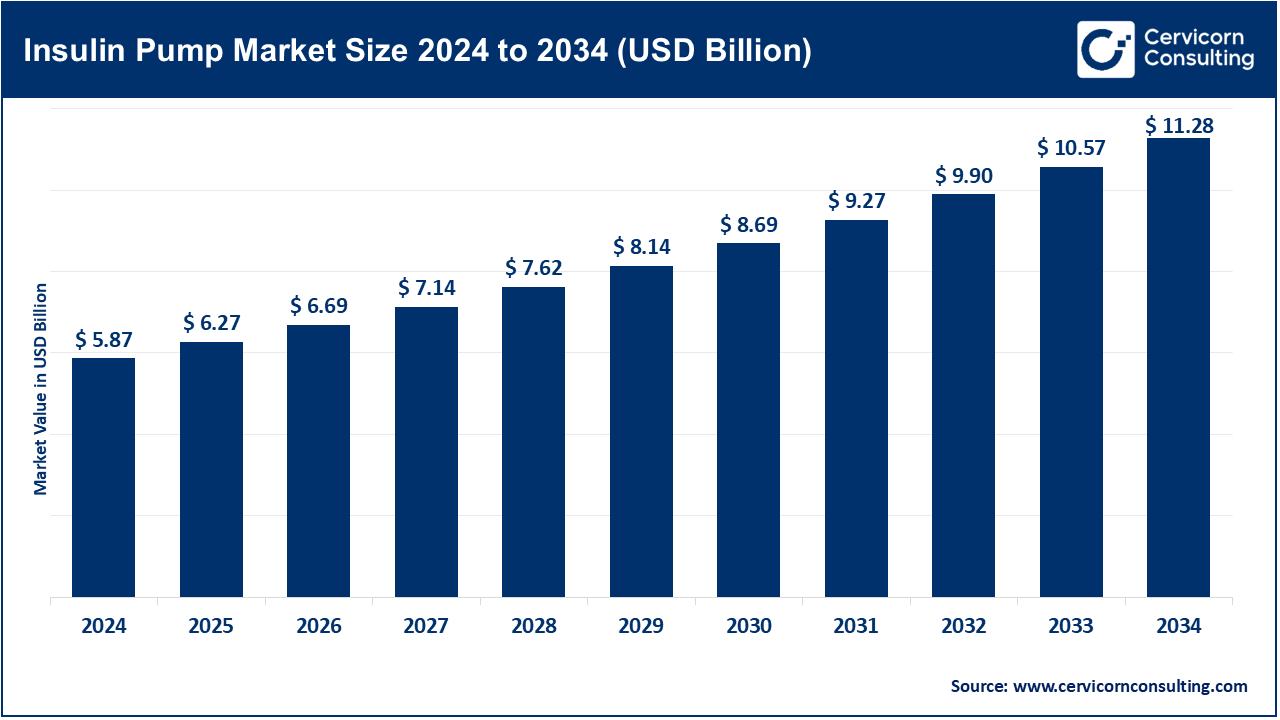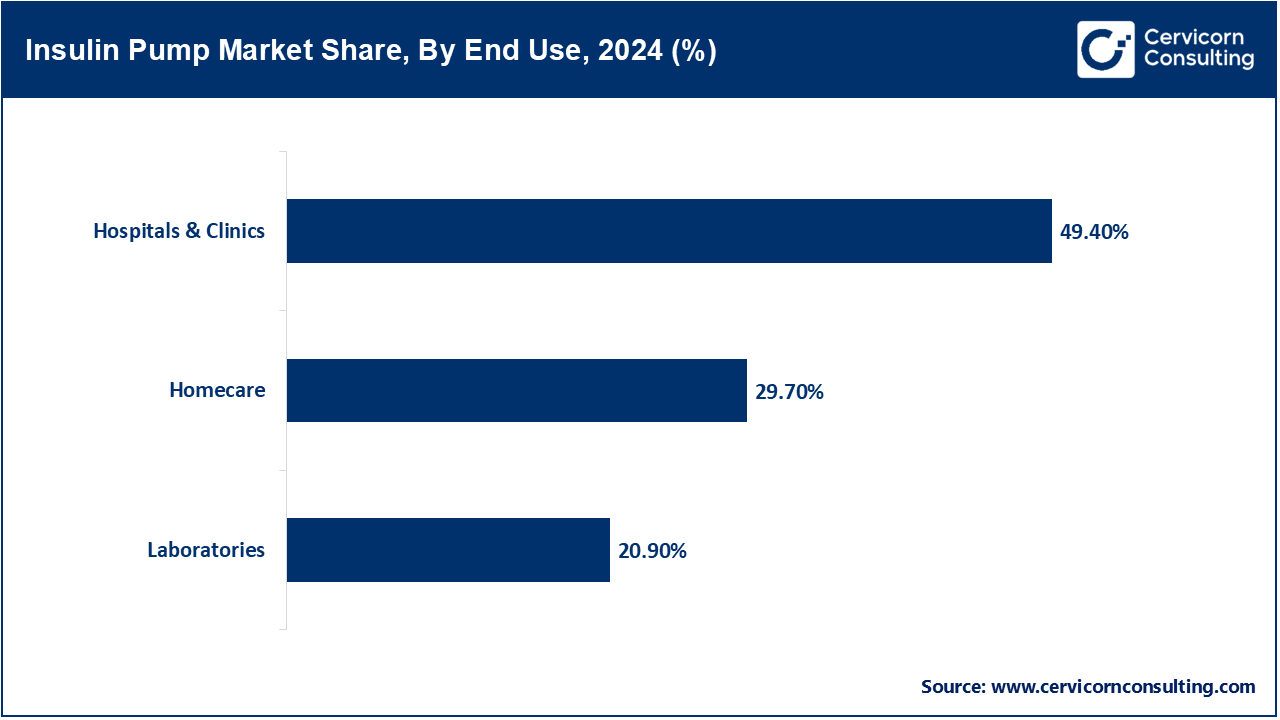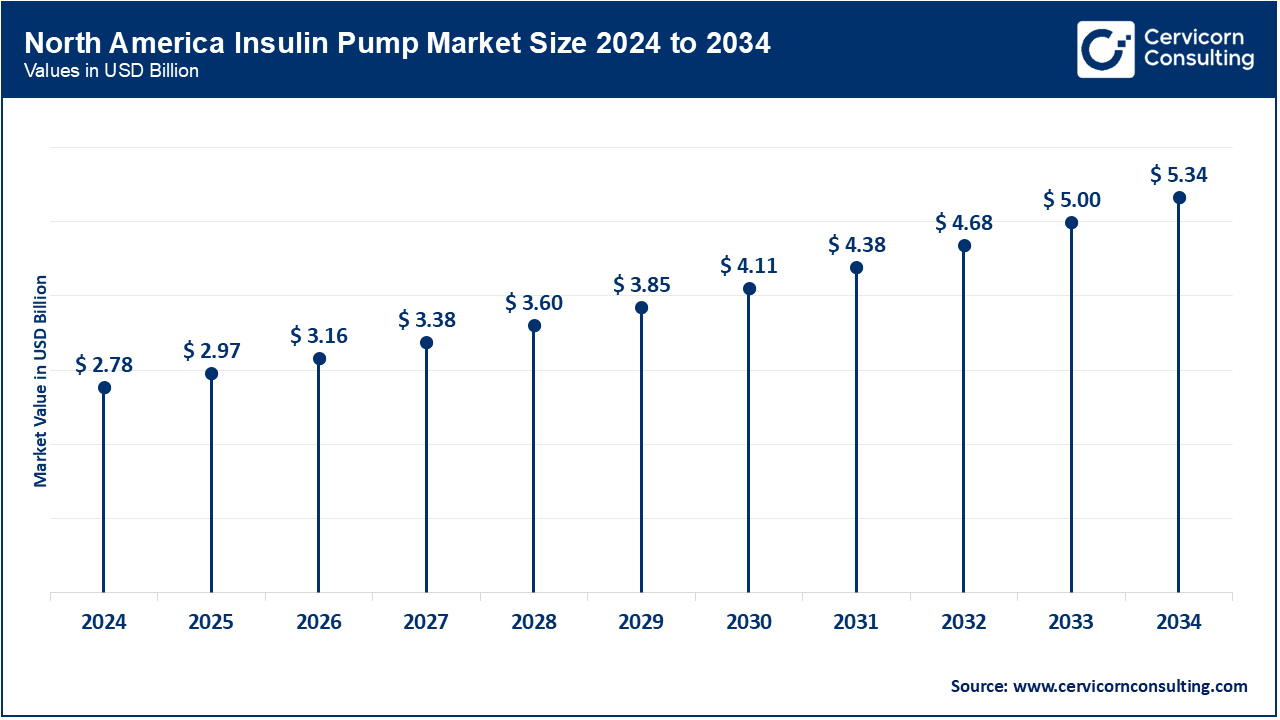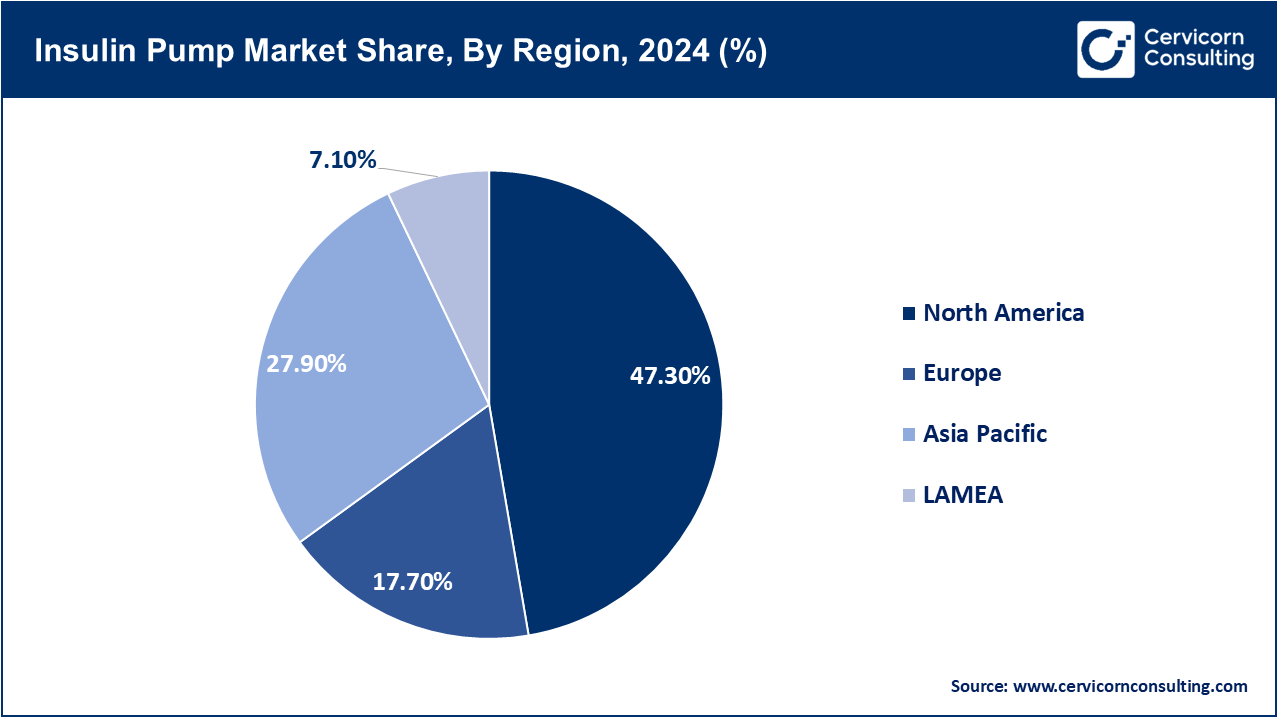The global insulin pump market size was reached at USD 5.87 billion in 2024 and is expected to exceed around USD 11.28 billion by 2034, growing at a compound annual growth rate (CAGR) of 8.7% over the forecast period from 2025 to 2034.
The global insulin pumps market is expected to grow significantly due to the rising prevalence of diabetes, particularly Type 1 diabetes, and the more sophisticated automated insulin delivery devices. Awareness and adoption by users and healthcare practitioners is shifting in favor of continuous subcutaneous insulin infusion (CSII) because of its advantages over injection-based methods. New technology, including hybrid closed-loop systems, pumps with continuous glucose monitors (CGMs), and smartphone-connected insulin pumps is enhancing both treatment precision and user experience. Moreover, developed and emerging markets are structurally stimulated by favorable reimbursement policies and widening telehealth frameworks.

The adoption of precision smart technologies, which facilitate automated insulin infusion, is transforming the insulin pump industry. The market is advancing due to a rise in diabetes cases, a growing acceptance of insulin pumps and wearable devices, improvements in continuous glucose monitoring technology, along with Bluetooth and smartphone integration with modern pumps. Additionally, closed-loop systems that emulate pancreatic functionality have also been integrated into insulin pumps. Outcomes and convenience for patients are improving via an evolving shift towards real-time, tailored insulin delivery. Innovation is spurred through strategic collaborations among medtech, digital health companies, and supportive regulation and reimbursement frameworks. With the advancement of AI and cloud-based analytics, insulin pumps are able to be manufactured to be smaller, smarter, and more responsive.
Report Scope
| Area of Focus | Details |
| Market Size in 2025 | USD 6.27 Billion |
| Expected Market Size in 2034 | USD 11.28 Billion |
| Projected Market CAGR 2025 to 2034 | 8.70% |
| Dominant Region | North America |
| Rapidly Expanding Region | Asia-Pacific |
| Key Segments | Type, Product, Disease Indication, Accessories, End Use, Region |
| Key Companies | Medtronic, Hoffmann-La Roche AG, Tandem Diabetes Care, Inc., Insulet Corporation, Ypsomed, Sanofi S.A., Sooil development, Jiangsu Delfu Co., Ltd., Cellnovo Ltd, Valeritas, Inc |
Tethered Pumps: The tethered insulin pumps remain important due to their large reservoir and reliable insulin delivery. We have reported in previous years the FDA’s changes to post-market surveillance for insulin pumps, and screening of materials used for pump tubing and their fittings from a safety and infection control perspective. These are still preferred in some clinical situations where subcutaneous insulin has to be continuously infused. The oversight review of legal frameworks has noted gaps in device governance, oversight concerning adverse event reporting and documentation which would protect the patient's rights. There have been some strides made in the initiatives toward the design of tubeless pumps, however, tethered pumps are still critical to the effective management of diabetes.
Insulin Pump Market Revenue Share, By Type, 2024 (%)
| Type | Revenue Share, 2024 (%) |
| Tethered Pumps | 64.80% |
| Patch Pumps | 35.20% |
Patch Pumps: The growing interest in patch pumps among the youth has been attributed to their direct skin attachment, making them more easily concealable. The 2023 approval of Omnipod 5 by the FDA has integrated CGM and furthered innovation in patch pumps. There is now a legal allowance for interlinked diabetes devices, which enhances user and safety friendliness. As reported by CDC, patch pump users have increased health and well-being alongside better treatment adherence. Regulators appear to drive with strong ambitions toward the patch pumps.
MiniMed: Medtronic's MiniMed 780G, which received FDA approval in 2023 for its hybrid closed-loop insulin delivery system, continues to lead the market with best-selling MiniMed pumps. This device enhances glycemic control while simultaneously mitigating risks of hypoglycemia. Medtronic complies with FDA safety and quality regulations, including rigorous adverse event reporting. Medtronic and other corporations ensure compliance in the advancement of diabetes care technologies. This order integrates compliance with other organizational frameworks illustrating interdisciplinary collaboration.
Accu-Chek: In 2024, Roche received FDA clearance for advanced Accu-Chek insulin pumps, which are now equipped with sophisticated CGM systems and include GDRP compliant data management systems for the US market. The company aligns with the strict use of public health programs in Europe and the US. The use of data privacy greatly influences the software design of Accu-Chek. Roche is active in the promotion of educational materials on the safe use of insulin pumps.
Tandem: As of 2023 Tandem Diabetes’s X2 pump, enhanced AI-driven insulin delivery and stringent cybersecurity compliance received FDA clearance. The corporation complies with federal interoperability mandates and post-market surveillance obligations as well. Tandem’s telehealth compliant remote software updates promote both user engagement and regulatory compliance. Regulatory policies enhance safety and facilitate connectivity between devices. Their compliance requirements within the homecare market stimulate creativity and advancement within the sector.
Omnipod: In 2023, Omnipod's patch pump was granted FDA’s designation of Breakthrough Device, which allowed quicker review due to the innovation of a tubeless design. Insulet Corporation complied with HHS regulations on Health and Information Systems Telehealth Care regarding Remote Monitoring. Compliance with the reporting obligations on medical device safety guarantees Insulet ongoing surveillance for safety oversight, which telehealth alignment provides compliance. Its popularity arises from the omnipod’s ease of use in the clinical and homecare settings.
Type 1 Diabetes: Individuals diagnosed with Type 1 Diabetes are exclusive users of insulin pumps because of their continuous physiological insulin deficiency. According to the CDC, approximately 1.6 million Americans are suffering from Type 1 Diabetes, a considerable portion of this population benefits from state-sponsored reimbursement programs for pump supplies. Regulatory authorities impose stringent safety regulations for devices used in this population due to their high vulnerability. Pumps designed specifically for Type 1 diabetics and integrated with artificial intelligence have received priority regulatory approvals because of their benefits on glycemic control and reduced hospitalization risks. These legal frameworks improve access to patients while ensuring device safety.
Insulin Pump Market Revenue Share, By Disease Indication, 2024 (%)
| Disease Indication | Revenue Share, 2024 (%) |
| Type 1 Diabetes | 69.40% |
| Type 2 Diabetes | 30620% |
Type 2 Diabetes: There is an increase in pump use among patients with more advanced stages of Type 2 diabetes requiring more intensive insulin therapy. An estimate by WHO indicates over 422 million people worldwide have diabetes, which is also accepted as a growing diabetes epidemic. With increasing acceptance of pumps for advanced management of Type 2 diabetes, regulators are revising policies to widen the scope of their use. Government policies now promote the use of pumps to minimize complications. Clinical trials that have been submitted for regulatory review since 2023 confirm the safety and effectiveness of pumps in this population.
Hospitals & Clinics: In 2024, hospitals and clinics lead the market, owing to their role in the diagnosis and treatment strategy development as well as in-device training supervision for diabetic patients. These multidisciplinary care systems also include an endocrinologist, a diabetes educator, and nursing staff, all of whom guarantee effective patient onboarding and insulin titration. In addition, hospital-grade monitoring systems offer safe insulin therapy management for patients at elevated risk. Improved reimbursement policies and coverage by insurance plans for inpatient pump therapy enhances the adoption of insulin pumps in clinical practice.

Homecare: This segment is fast growing in the market, owing to advancements in the ease of interface, wireless data transfer, and remote monitoring. There is a growing preference among patients, especially those with Type 1 diabetes, to control their insulin management from the comfort of their home which offers autonomy and minimizes hospital visits. Real-time glucose monitoring and pump adjustments facilitated by telehealth, mobile and computer apps, and virtual consultations make homecare an efficient and economical option for chronic disease management needing limited clinical supervision.
Laboratories: Clinics and diagnostic laboratories perform a distinctive but critical role concerning insulin pumps. Their roles encompass clinical trials and research and development activities. They also assist in the verification and validation processes pertaining to the device's performance. Through safety and efficacy testing and usability evaluation, they provide assistive evaluation technology in controlled environments. Additionally, diagnostic laboratories assist in analyzing glycemic trends and identifying biomarkers for pump algorithm optimization to inform insulin delivery systems. Even though clinics and diagnostic laboratories are not direct points of care, their work helps ensure that insulin pumps are safe from clinical risk, technological failure, and regulatory non-compliance as well as pre-emptively tested for all risks before the devices reach the hospitals or homecare.
The insulin pump market is segmented into several key regions: North America, Europe, Asia-Pacific, and LAMEA (Latin America, Middle East, and Africa). Here’s an in-depth look at each region.

The insulin pump sector within North America is spearheaded by the US, Canada, and Mexico. It is under strict control of the FDA and Health Canada which guarantees safety and innovation of the devices. The US FDA’s 2023 pumps interoperability and cybersecurity guidance boosts the reception of new devices with AI features. Canada’s Health Canada has strengthened post-market surveillance protocols thus increasing patient safety. Mexico is expanding access with government healthcare programs on diabetes management and the recently passed law liberalizing the approval of medical devices. The region benefits from Medicare and Medicaid strong reimbursement policies which encourage the use of homecare insulin pumps. Cross-border regulatory harmonization efforts focus on the reduction of approval processes which would increase innovation.
The insulin pump industry in Europe encompasses the UK, Germany, and France, all of whom fall under the EMA as well as GDPR data protection legislation which impacts the device's functionality. UK's MHRA amends the regulatory scope for device approvals in 2024 to accelerate innovation in diabetes care, including CGM-integrated pumps. Germany requires strict safety and clinical evaluation compliance with the EU MDR for France’s Promoting diabetes care initiatives with enhanced reimbursement for pump therapies is france’s latest. The safety surveillance of devices still remains a focus of the EMA across member states. The legal aspects supporting telemedicine have eased pump adoption in remote regions. The focus of collaboration among European agencies centers on the need for coherent and integrative safety policies that foster innovation while maintaining the safety and security of the patient.

The region is made up of China, India, Japan, Australia and South Korea, which are becoming quick adopters of insulin pumps under new policies. China’s NMPA streamlined the approval processes in 2023 for devices with multi-interface connectivity and interoperability. The CDSCO of India expanded access to the market by adopting regulatory policies for reimbursable diabetes control devices in 2024. In Japan, the PMDA grants comprehensive fast-track approvals and performs post-marketing evaluation for sophisticated pump systems, whereas Australia’s TGA has recently enhanced safety through stricter quality regulations on medical devices. South Korea adheres to KFDA regulations which align with other countries' best practices. Government telehealth and health promotion initiatives facilitate the growing use of insulin pumps in hospitals and homecare services.
Latin America and the Middle East & Africa (MEA) are improving the adoption of insulin pumps with new regulatory changes and investments in healthcare. In Brazil, ANVISA revised device regulations to enhance safegaurds whilst increase in government reimbursement for diabetes technology. Telemedicine for remote patient monitoring is also expanding in adjacent countries. In MEA, the UAE revised medical device regulations in 2024, Saudi SFDA strengthened post-market surveillance in 2023, and SAHPRA is globally aligning approval processes with South African legislation. Both regions focus on telehealth expansion and governmental strategies for diabetes care, fostered by supranational regulatory partnerships to strengthen patient safety and innovation.
Recent partnerships in the insulin pump industry underscore innovation in diabetes care and integration of connected health technologies. Tandem Diabetes Care partnered with Dexcom to integrate the Dexcom G7 continuous glucose monitor with its X2 insulin pump, enhancing real-time glucose control. Medtronic collaborates with the Mayo Clinic to advance closed-loop insulin delivery research and AI-based diabetes management. Insulet Corporation joined forces with Abbott to integrate the Omnipod insulin delivery system with Abbott’s FreeStyle Libre sensor, aiming for a seamless user experience. Roche partnered with Senseonics to explore implantable glucose monitoring and data-sharing ecosystems. These alliances aim to improve interoperability, user convenience, and personalized insulin therapy. Collectively, they push the market toward smarter, more connected, and user-centric diabetes solutions.
Market Segmentation
By Type
By Product
By Disease Indication
By Accessories
By End Use
By Region
Chapter 1 Market Introduction and Overview
1.1 Market Definition and Scope
1.1.1 Overview of Insulin Pump
1.1.2 Scope of the Study
1.1.3 Research Timeframe
1.2 Research Methodology and Approach
1.2.1 Methodology Overview
1.2.2 Data Sources and Validation
1.2.3 Key Assumptions and Limitations
Chapter 2 Executive Summary
2.1 Market Highlights and Snapshot
2.2 Key Insights by Segments
2.2.1 By Type Overview
2.2.2 By Product Overview
2.2.3 By Disease Indication Overview
2.2.4 By Accessories Overview
2.2.5 By End Use Overview
2.3 Competitive Overview
Chapter 3 Global Impact Analysis
3.1 Russia-Ukraine Conflict: Global Market Implications
3.2 Regulatory and Policy Changes Impacting Global Markets
Chapter 4 Market Dynamics and Trends
4.1 Market Dynamics
4.1.1 Market Drivers
4.1.1.1 Favorable Reimbursement Policies
4.1.1.2 Increased Spending on Healthcare
4.1.1.3 Advancements in Technology in AI and Machine Learning
4.1.2 Market Restraints
4.1.2.1 High Device Costs
4.1.2.2 Limited Insurance Coverage
4.1.2.3 Device Errors and User Errors
4.1.3 Market Challenges
4.1.3.1 Cybersecurity Risks
4.1.3.2 Regulatory Challenges
4.1.4 Market Opportunities
4.1.4.1 Expansion in Emerging Markets
4.1.4.2 Advancement in Developing Low-Cost Devices
4.1.4.3 Incorporation of Telehealth Services
4.2 Market Trends
Chapter 5 Premium Insights and Analysis
5.1 Global Insulin Pump Market Dynamics, Impact Analysis
5.2 Porter’s Five Forces Analysis
5.2.1 Bargaining Power of Suppliers
5.2.2 Bargaining Power of Buyers
5.2.3 Threat of Substitute Products
5.2.4 Rivalry among Existing Firms
5.2.5 Threat of New Entrants
5.3 PESTEL Analysis
5.4 Value Chain Analysis
5.5 Product Pricing Analysis
5.6 Vendor Landscape
5.6.1 List of Buyers
5.6.2 List of Suppliers
Chapter 6 Insulin Pump Market, By Type
6.1 Global Insulin Pump Market Snapshot, By Type
6.1.1 Market Revenue (($Billion) and Growth Rate (%), 2022-2034
6.1.1.1 Tethered Pumps
6.1.1.2 Patch Pumps
Chapter 7 Insulin Pump Market, By Product
7.1 Global Insulin Pump Market Snapshot, By Product
7.1.1 Market Revenue (($Billion) and Growth Rate (%), 2022-2034
7.1.1.1 MiniMed
7.1.1.2 Accu-Chek
7.1.1.3 Tandem
7.1.1.4 Omnipod
7.1.1.5 Others
Chapter 8 Insulin Pump Market, By Disease Indication
8.1 Global Insulin Pump Market Snapshot, By Disease Indication
8.1.1 Market Revenue (($Billion) and Growth Rate (%), 2022-2034
8.1.1.1 Type 1 Diabetes
8.1.1.2 Type 2 Diabetes
Chapter 9 Insulin Pump Market, By Accessories
9.1 Global Insulin Pump Market Snapshot, By Accessories
9.1.1 Market Revenue (($Billion) and Growth Rate (%), 2022-2034
9.1.1.1 Insulin reservoir or cartridges
9.1.1.2 Insulin set insertion devices
9.1.1.3 Battery
Chapter 10 Insulin Pump Market, By End Use
10.1 Global Insulin Pump Market Snapshot, By End Use
10.1.1 Market Revenue (($Billion) and Growth Rate (%), 2022-2034
10.1.1.1 Hospitals & clinics
10.1.1.2 Homecare
10.1.1.3 Laboratories
Chapter 11 Insulin Pump Market, By Region
11.1 Overview
11.2 Insulin Pump Market Revenue Share, By Region 2024 (%)
11.3 Global Insulin Pump Market, By Region
11.3.1 Market Size and Forecast
11.4 North America
11.4.1 North America Insulin Pump Market Revenue, 2022-2034 ($Billion)
11.4.2 Market Size and Forecast
11.4.3 North America Insulin Pump Market, By Country
11.4.4 U.S.
11.4.4.1 U.S. Insulin Pump Market Revenue, 2022-2034 ($Billion)
11.4.4.2 Market Size and Forecast
11.4.4.3 U.S. Market Segmental Analysis
11.4.5 Canada
11.4.5.1 Canada Insulin Pump Market Revenue, 2022-2034 ($Billion)
11.4.5.2 Market Size and Forecast
11.4.5.3 Canada Market Segmental Analysis
11.4.6 Mexico
11.4.6.1 Mexico Insulin Pump Market Revenue, 2022-2034 ($Billion)
11.4.6.2 Market Size and Forecast
11.4.6.3 Mexico Market Segmental Analysis
11.5 Europe
11.5.1 Europe Insulin Pump Market Revenue, 2022-2034 ($Billion)
11.5.2 Market Size and Forecast
11.5.3 Europe Insulin Pump Market, By Country
11.5.4 UK
11.5.4.1 UK Insulin Pump Market Revenue, 2022-2034 ($Billion)
11.5.4.2 Market Size and Forecast
11.5.4.3 UKMarket Segmental Analysis
11.5.5 France
11.5.5.1 France Insulin Pump Market Revenue, 2022-2034 ($Billion)
11.5.5.2 Market Size and Forecast
11.5.5.3 FranceMarket Segmental Analysis
11.5.6 Germany
11.5.6.1 Germany Insulin Pump Market Revenue, 2022-2034 ($Billion)
11.5.6.2 Market Size and Forecast
11.5.6.3 GermanyMarket Segmental Analysis
11.5.7 Rest of Europe
11.5.7.1 Rest of Europe Insulin Pump Market Revenue, 2022-2034 ($Billion)
11.5.7.2 Market Size and Forecast
11.5.7.3 Rest of EuropeMarket Segmental Analysis
11.6 Asia Pacific
11.6.1 Asia Pacific Insulin Pump Market Revenue, 2022-2034 ($Billion)
11.6.2 Market Size and Forecast
11.6.3 Asia Pacific Insulin Pump Market, By Country
11.6.4 China
11.6.4.1 China Insulin Pump Market Revenue, 2022-2034 ($Billion)
11.6.4.2 Market Size and Forecast
11.6.4.3 ChinaMarket Segmental Analysis
11.6.5 Japan
11.6.5.1 Japan Insulin Pump Market Revenue, 2022-2034 ($Billion)
11.6.5.2 Market Size and Forecast
11.6.5.3 JapanMarket Segmental Analysis
11.6.6 India
11.6.6.1 India Insulin Pump Market Revenue, 2022-2034 ($Billion)
11.6.6.2 Market Size and Forecast
11.6.6.3 IndiaMarket Segmental Analysis
11.6.7 Australia
11.6.7.1 Australia Insulin Pump Market Revenue, 2022-2034 ($Billion)
11.6.7.2 Market Size and Forecast
11.6.7.3 AustraliaMarket Segmental Analysis
11.6.8 Rest of Asia Pacific
11.6.8.1 Rest of Asia Pacific Insulin Pump Market Revenue, 2022-2034 ($Billion)
11.6.8.2 Market Size and Forecast
11.6.8.3 Rest of Asia PacificMarket Segmental Analysis
11.7 LAMEA
11.7.1 LAMEA Insulin Pump Market Revenue, 2022-2034 ($Billion)
11.7.2 Market Size and Forecast
11.7.3 LAMEA Insulin Pump Market, By Country
11.7.4 GCC
11.7.4.1 GCC Insulin Pump Market Revenue, 2022-2034 ($Billion)
11.7.4.2 Market Size and Forecast
11.7.4.3 GCCMarket Segmental Analysis
11.7.5 Africa
11.7.5.1 Africa Insulin Pump Market Revenue, 2022-2034 ($Billion)
11.7.5.2 Market Size and Forecast
11.7.5.3 AfricaMarket Segmental Analysis
11.7.6 Brazil
11.7.6.1 Brazil Insulin Pump Market Revenue, 2022-2034 ($Billion)
11.7.6.2 Market Size and Forecast
11.7.6.3 BrazilMarket Segmental Analysis
11.7.7 Rest of LAMEA
11.7.7.1 Rest of LAMEA Insulin Pump Market Revenue, 2022-2034 ($Billion)
11.7.7.2 Market Size and Forecast
11.7.7.3 Rest of LAMEAMarket Segmental Analysis
Chapter 12 Competitive Landscape
12.1 Competitor Strategic Analysis
12.1.1 Top Player Positioning/Market Share Analysis
12.1.2 Top Winning Strategies, By Company, 2022-2024
12.1.3 Competitive Analysis By Revenue, 2022-2024
12.2 Recent Developments by the Market Contributors (2024)
Chapter 13 Company Profiles
13.1 Medtronic
13.1.1 Company Snapshot
13.1.2 Company and Business Overview
13.1.3 Financial KPIs
13.1.4 Product/Service Portfolio
13.1.5 Strategic Growth
13.1.6 Global Footprints
13.1.7 Recent Development
13.1.8 SWOT Analysis
13.2 Hoffmann-La Roche AG
13.3 Tandem Diabetes Care, Inc.
13.4 Insulet Corporation
13.5 Ypsomed
13.6 Sanofi S.A.
13.7 Sooil development
13.8 Jiangsu Delfu Co., Ltd.
13.9 Cellnovo Ltd
13.10 Valeritas, Inc